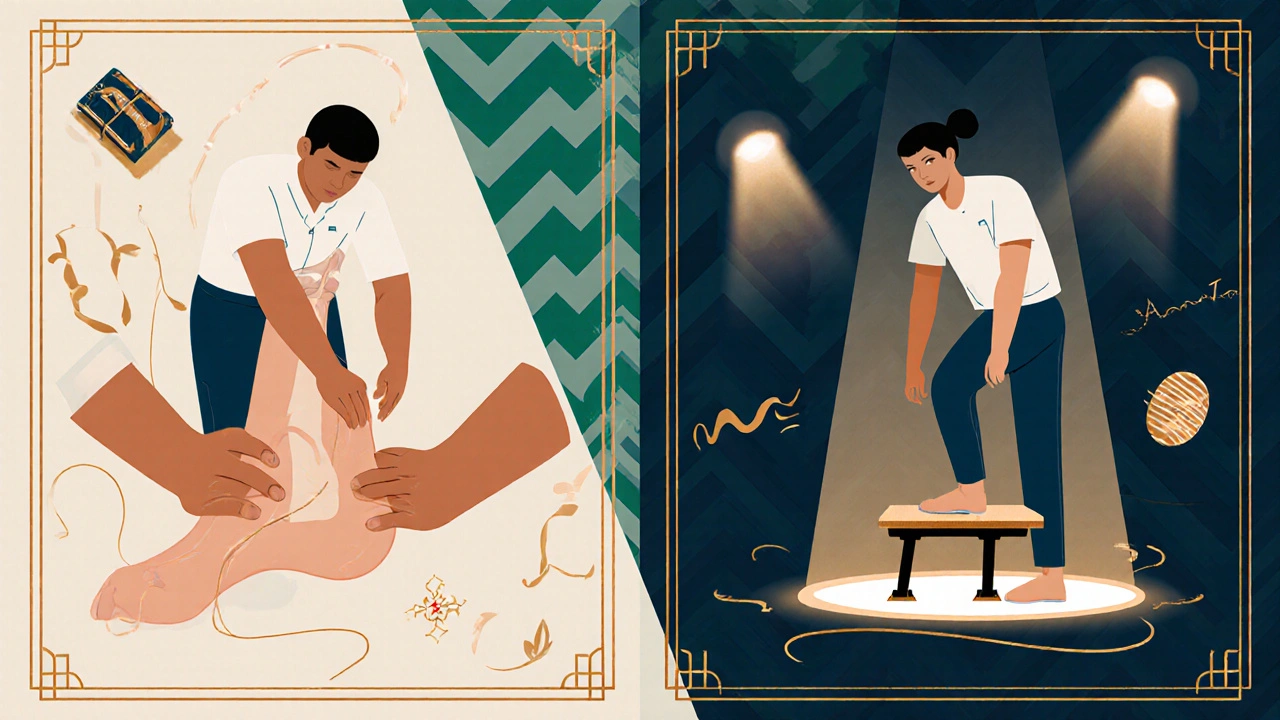Physical Therapy Benefits for Fast Tendonitis Recovery
 Oct, 21 2025
Oct, 21 2025
Tendonitis Recovery Plan Builder
Personalized Tendonitis Recovery Plan
Get targeted physical therapy recommendations based on your specific tendonitis location and recovery phase.
Your Personalized Recovery Plan
When Physical therapy is a rehabilitative treatment that uses exercise, manual techniques, and education to restore movement and reduce pain, it can be a game‑changer for tendonitis - an inflammation of a tendon caused by overuse or injury. If you’ve ever felt a sharp ache in your wrist, elbow, shoulder, knee or heel after a marathon training session, you know how quickly a minor strain can turn into a frustrating, lingering problem. In this guide we’ll break down why targeting the tendon with guided movement, hands‑on care, and smart loading works better than just “resting” and how you can set up a recovery plan that gets you back to the activities you love.
Quick Takeaways
- Physical therapy promotes blood flow and collagen synthesis, speeding up tendon healing.
- Combining exercise therapy with manual techniques reduces pain faster than medication alone.
- Tailored strength and flexibility work prevents re‑injury for up to 80% of patients.
- Consistent, low‑intensity loading is the single most effective factor for tissue remodeling.
- Professional guidance minimizes the risk of worsening inflammation.
What Exactly Is Tendonitis?
Tendonitis (or tendinitis) is the medical term for inflammation of a tendon - the thick, fibrous cords that attach muscle to bone. Common sites include the Achilles, rotator cuff, tennis elbow (lateral epicondylitis) and patellar tendon. The condition usually follows repetitive strain, sudden overload, or poor biomechanics, leading to microscopic tears, fluid buildup, and a sharp, achy pain that worsens with activity.
Key signs are:
- Stiffness and tenderness along the tendon line.
- Pain that eases with rest but returns quickly when you move.
- Visible swelling or a warm feeling around the affected area.
While anti‑inflammatory drugs can mask the pain, they do little to repair the damaged fibers. That’s where physical therapy steps in - it addresses the root cause, not just the symptom.
How Physical Therapy Helps Tendon Healing
Physical therapists (PTs) use a blend of science and hands‑on skill to create a healing environment. The main ways PT accelerates recovery are:
- Increasing blood flow. Gentle movement and modalities like heat therapy stimulate circulation, delivering oxygen and nutrients that are vital for collagen production.
- Promoting collagen alignment. Controlled loading encourages the newly formed collagen fibers to line up in the direction of stress, making the tendon stronger.
- Reducing scar tissue. Stretching and mobilizations break down adhesions, preserving flexibility and normal gliding motion.
- Re‑educating movement patterns. Faulty biomechanics often trigger tendonitis. PT corrects these patterns through motor control drills.
- Managing pain without opioids. Techniques such as manual therapy, ultrasound, and targeted exercises lower pain thresholds, letting you stay active without heavy medication.
Core Physical Therapy Techniques for Tendonitis
| Technique | Primary Benefit | Typical Session Frequency |
|---|---|---|
| Exercise therapy | Improves tensile strength and promotes proper loading | 3‑5 times/week |
| Manual therapy | Breaks down adhesions, restores joint mobility | 1‑2 times/week |
| Heat therapy | Increases blood flow, reduces stiffness | As needed, often before exercises |
| Ultrasound | Speeds cellular metabolism, aids tissue repair | 2‑3 times/week (short bursts) |
| Stretching | Improves flexibility, reduces tension on tendon | Daily, post‑exercise |
| Strength training | Builds muscle support around the tendon | 2‑4 times/week |
Let’s unpack each technique a bit more so you know what to expect when you walk into a clinic.

Exercise Therapy - The Cornerstone
Exercise therapy is more than “do a few reps.” PTs prescribe isotonic, eccentric, and isometric movements that match the tendon’s healing stage. Early on, low‑load isometric holds can reduce pain without stressing the tissue. As inflammation subsides, eccentric loading (slowly lengthening the tendon under tension) has the strongest evidence for chronic Achilles and patellar tendonitis - studies show a 30‑40% faster return to sport compared to rest alone.
Typical exercises include:
- Theraband wrist extensions for tennis elbow.
- Heel‑drop eccentric raises for Achilles issues.
- Scapular retraction rows for rotator‑cuff tendonitis.
Consistent, progressive loading signals the body to lay down new collagen in the correct orientation, turning a weak spot into a resilient fiber bank.
Manual Therapy - Hands‑On Healing
Manual therapy involves skilled hands‑on techniques like soft‑tissue mobilization, friction massage, and joint glides. By applying controlled pressure, the therapist can break down scar tissue, improve fascial sliding, and stimulate proprioceptive receptors that modulate pain signals. Think of it as a “reset button” for the nervous system, allowing the subsequent exercises to be performed with better range and less guarding.
When combined with exercises, manual therapy has been shown to cut recovery time by roughly 20%.
Heat Therapy & Ultrasound - Adjunct Modalities
Heat therapy (warm packs, paraffin baths) dilates blood vessels, delivering oxygen‑rich blood right where the tendon needs it. Most PTs apply heat for 10‑15 minutes before active exercises to soften tissue and improve flexibility.
Therapeutic ultrasound delivers high‑frequency sound waves that vibrate cells, enhancing metabolic activity and collagen synthesis. While the evidence is mixed, many clinicians report a short‑term reduction in pain and stiffness, making it a useful bridge between rest and active loading.
Stretching & Strength Training - Long‑Term Protection
Proper stretching maintains the length‑tension relationship of the muscle‑tendon unit. Daily static stretches held for 30 seconds, performed after a warm‑up, keep the tendon from becoming overly tight.
Strength training adds a protective layer by building the surrounding musculature. For a runner with Achilles tendonitis, calf‑raise progressions (starting with both legs, moving to single‑leg, then adding weight) gradually increase tendon load without over‑taxing it.

Designing Your Personal PT Plan
Every tendonitis case is unique, but most plans follow a three‑phase roadmap:
- Acute Phase (Days 1‑7). Goal: control inflammation and pain. Use gentle ice (if swelling is high), heat before short walks, and begin isometric holds (<10 seconds) 2‑3 times daily.
- Sub‑Acute Phase (Weeks 2‑4). Goal: restore mobility. Introduce manual therapy sessions twice a week, start light eccentric exercises (e.g., 3 sets of 10 heel drops), and add daily stretching.
- Functional Phase (Weeks 5‑8+). Goal: rebuild strength and return to sport. Increase exercise load by 10% each week, incorporate sport‑specific drills, and maintain weekly manual therapy for fine‑tuning.
Key tip: Keep a simple log of pain (0‑10 scale), activity, and what you did in the session. Looking at trends helps both you and your therapist adjust the plan before setbacks occur.
Common Pitfalls and How to Dodge Them
Even with a solid PT plan, many people stumble. Here are the usual suspects and quick fixes:
- Skipping “pain‑free” days. Rest is good, but total inactivity leads to stiffness. Keep moving, even if it’s a gentle range‑of‑motion routine.
- Doing too much, too soon. Jumping from light isometrics to heavy lifting triggers a flare‑up. Follow the 10% rule: increase load no more than 10% per week.
- Ignoring biomechanics. Poor posture or uneven footwear can repeatedly stress the same tendon. Ask your PT for gait analysis or ergonomic advice.
- Relying solely on medication. NSAIDs mask pain but don’t heal. Use them sparingly and pair with PT exercises.
- Skipping follow‑up appointments. Tendon healing is a slow process that needs regular reassessment. Even a 15‑minute check‑in can keep you on track.
Success Stories - Real‑World Proof
Sarah, a 34‑year‑old marathon runner from Cape Town, developed Achilles tendonitis after increasing her weekly mileage. After two weeks of icing and rest, she consulted a PT. The therapist started her on eccentric heel‑drops, manual mobilization, and a calf‑strengthening circuit. Within six weeks, Sarah reported a pain level of 1/10 and was back to her regular training schedule. She credits the structured PT plan for preventing a months‑long layoff.
Mark, a 45‑year‑old piano teacher, suffered lateral elbow pain (tennis elbow) from repetitive practice. His PT combined forearm Theraband extensions, soft‑tissue massage, and heat therapy before each session. After eight weeks, Mark could play a full‑length concerto without discomfort, something he hadn’t managed in over a year.
These anecdotes underline a core truth: tendonitis isn’t a “just rest it” injury. Targeted rehabilitation, guided by a qualified PT, shortens downtime and builds a stronger, more resilient tendon.
Frequently Asked Questions
How soon can I start physical therapy after a tendon injury?
Most therapists begin with gentle isometric exercises and manual therapy within the first few days, as long as swelling is under control. Early movement helps prevent stiffness while keeping the tendon protected.
Is heat therapy safe during the acute inflammation phase?
During the first 48‑72 hours, most clinicians prefer ice to curb swelling. Heat becomes useful once the acute swelling recedes, typically after the first week, to improve blood flow before exercises.
Can I do tendon‑specific exercises at home without a therapist?
Yes, as long as you follow a graduated plan and avoid painful overload. Many PTs provide handouts or video guides for home use, but a few in‑clinic sessions ensure you’re performing movements correctly.
What’s the difference between tendonitis and tendinosis?
Tendonitis refers to acute inflammation, while tendinosis describes chronic degeneration of tendon fibers without much inflammation. PT strategies overlap, but tendinosis often requires longer, more gradual loading.
How long does a typical tendonitis recovery take with physical therapy?
Recovery timelines vary by location and severity, but most patients see a noticeable reduction in pain within 4-6 weeks and can return to full activity by 8-12 weeks when following a regular PT program.
Bottom line: tendonitis doesn’t have to sideline you for months. By pairing the science of controlled loading with hands‑on techniques, physical therapy gets blood, collagen, and confidence back into the injured tendon. Stick to a structured plan, listen to your body, and let a qualified PT guide your journey. You’ll be back to lifting, running, or playing your favorite instrument faster than you’d expect.
Eli Soler Caralt
October 21, 2025 AT 20:11Wow, such a profound revelation 😏
Eryn Wells
October 21, 2025 AT 21:34Great rundown! 🌟 The way you break down each technique makes it so accessible for anyone tackling tendonitis.
Kathrynne Krause
October 21, 2025 AT 23:47Oh my, this guide is a sparkling treasure chest of rehab wisdom! 🎉 I especially love the vivid analogy of the tendon as a "fiber bank"-so vivid! Keep spreading these empowering vibes.
Chirag Muthoo
October 22, 2025 AT 03:07The presented modalities align well with current evidence‑based protocols. A measured approach, beginning with gentle isometrics, respects tissue tolerance. Integrating manual therapy as a neurophysiological reset can indeed facilitate subsequent loading. Consistency, as you emphasize, remains paramount.
Kimberly Lloyd
October 22, 2025 AT 07:17Embarking on a tendonitis recovery journey is akin to composing a symphony, where each instrument must play in harmony. The first movement begins with calm, controlled isometric holds, gently coaxing pain away while the tissue whispers its readiness for more. As the inflammation wanes, the second movement introduces eccentric loading, the true hero that re‑aligns collagen fibers with purposeful grace. This phase is not a sprint; it is a deliberate marathon, where progressive overload builds resilience over weeks. Third, we intertwine manual therapy, a subtle brushstroke that dissolves adhesions and awakens proprioceptive pathways. The fourth act layers heat therapy, a warm embrace that flushes oxygen‑rich blood into the healing zone. While some may champion ultrasound, think of it as a fleeting spotlight, useful but not the main performer. Stretching then becomes the lyrical cadence, preserving length‑tension harmony and preventing future stiffness. Strength training is the robust bass line, fortifying surrounding muscles to shield the tender tendon. Throughout, patient education acts as the conductor, guiding timing, load, and rest with deliberate precision. Consistency, as you highlighted, is the metronome that keeps the entire ensemble in sync. Remember, regression is not failure; it is a moment to reassess loading intensity and technique. Celebrate small victories-each painless rep is a note in the crescendo of recovery. Finally, integrate functional drills that mimic daily activities, ensuring the healed tendon translates to real‑world performance. In sum, this orchestrated approach transforms a painful episode into a triumphant encore of strength and mobility.
Sakib Shaikh
October 22, 2025 AT 12:17Listen up, folks, the science is crystal clear-if you skip eccentric loading you’re basically asking for a comeback of the injury! I’ve seen countless cases where negligence leads to chronic misery. Don’t be the one who blames the therapist later!
Devendra Tripathi
October 22, 2025 AT 17:51Your poetic nonsense distracts from the real issue-stop sugar‑coating rehab with glitter!
Jake Hayes
October 22, 2025 AT 23:57While the tone is friendly, the evidence for ultrasound remains weak; prioritize loading.
parbat parbatzapada
October 23, 2025 AT 06:37Sure, the ‘consistent loading’ mantra is just a ploy by the PT industry to sell endless sessions. They don’t want you to heal on your own.
Casey Cloud
October 23, 2025 AT 13:51Pro tip: follow a 10‑% weekly increase rule for load-add a small amount of resistance each week to keep the tendon adapting without overloading it.